“When I was a schoolboy my map of the United States showed between the Missouri River and the Rocky Mountains a long and broad white blotch, upon which was printed in small capitals ‘THE GREAT AMERICAN DESERT – UNEXPLORED.'”
— Colonel Richard Irving Dodge. “The Hunting Grounds of the Great West.”
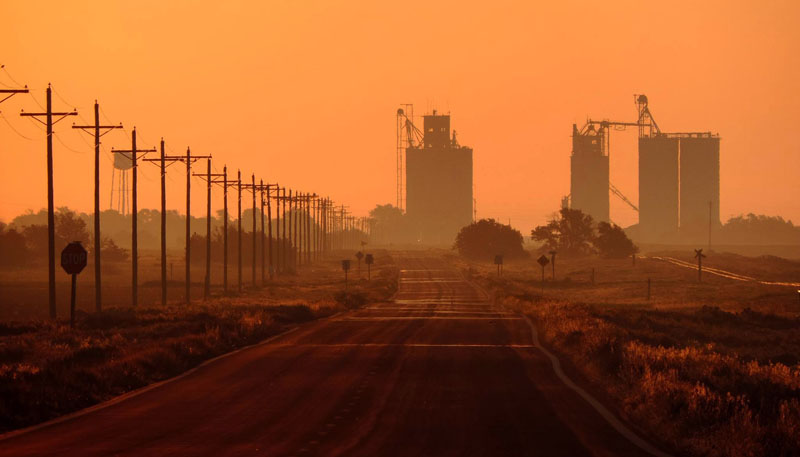
It takes a few days to decide that you’re seeing grasshoppers. They could almost be little twigs, or droppings from the long grain trucks that have been slowing traffic on the highways for the past few weeks. In the fields are the stubby remains of the winter wheat crop. It’s easy to assume that a few dry strands of the old wheat would blow onto the pavement. What you’re seeing on the road surface is thin and wheat-colored, and sometimes seems to be blowing idly with the summer wind. It could be wheat, except that wheat doesn’t jump like that. So that means the grasshoppers are back. And that means it’s late summer on the plains. Late summer brings sweet corn to the markets. That’s when the tomatoes ripen in the garden and trucks roll in with Colorado Peaches. Late summer is hot and dusty. And it is the time for the annual County Fair.
It’s been ten years since I wrote a Zephyr article about attending the County Fair. That was the summer of 2011. Our first full summer here. And in the last decade, to be perfectly honest, we hadn’t gone back. Some years, we were on the road in late July. Other years, I decided I was too busy assembling the next issue of the paper. Or it was just too hot. Most of the time, I didn’t bother to come up with an explanation. It wasn’t a priority. But this year, we finally made it back. We sat in the bleachers at the rodeo grounds and watched the Horse Show on a Tuesday night. The next night, we returned for the ranch rodeo. And, sitting among the scattered crowd, I felt more than a little guilty about those intervening summers.
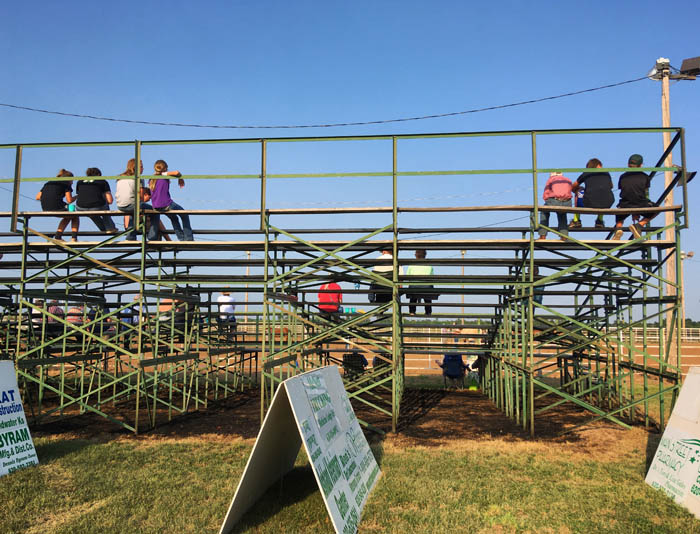
Rereading my article from the summer of 2011, I remember that I walked through the displays of prize squashes and artwork. I perused the baked goods sale. Jim and I had only lived here for ten months then, and I still felt like an outsider. I wrote about our new home as a place of simplicity and innocence. I actually used those words–”simplicity” and “innocence”–in the piece I wrote about the County Fair. Reading that now, I shake my head. It’s amazing what a decade will change in your thinking.
This year, I sat in the bleachers watching the men stream across the rodeo grounds on their horses, lassos swinging above their heads. I wasn’t analyzing this particularly rural scene as an outsider anymore. I was thinking about how I’d lived this way my whole life, really. With only short breaks, I had lived entirely on the plains. And I thought it was odd that I had never particularly identified myself with it.
I was raised in this prairie world. The Black Hills, where I grew up, are an island on the plains. Each day, the drive from home to school meant a descent past the timber line onto the grasslands. Sturgis was a ranch town. Even Rapid City was a prairie city. When I think of those places, I can immediately summon an image of the grasses, variegated and wind-tossed, in all their shades of gold and reddish brown. People talk a lot about the prairie skies, and for good reason. But no one talks enough about the colors of the grass.
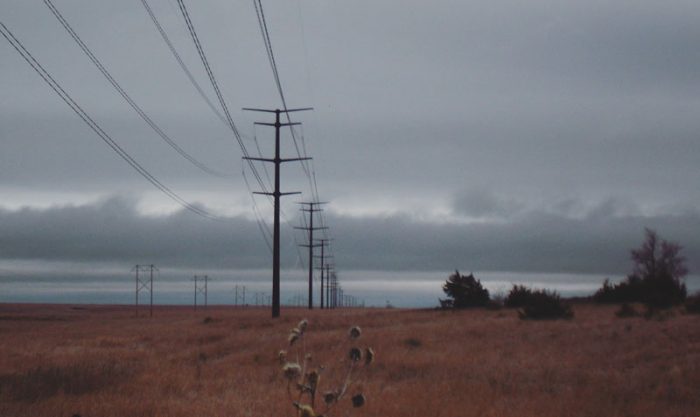
*** *** ***
Even a decade ago, when I used the words “simplicity” and “innocence,” I acknowledged that no place is simple. No place, even a little prairie town, is truly innocent. I was responding to the drawings of horses and the cowboy poetry on display in the county fair exhibits, and I felt that this was a place where people still valued those ideals. That this was a place that valued innocence, even if it couldn’t be truly innocent. This was a place that didn’t want to be swept into the chaos of the modern world. People here seemed to look back to the past for guidance, even as they were led forward. I was grateful to have moved here.
It isn’t the only reason we chose this place, but a person could easily choose to live on the plains just for the people. By and large, they are good-humored, appreciative and helpful. The general sentiment is “live and let live,” but in a moment of crisis somebody will knock on the door. Someone will show up with a casserole. These were the sort of people I knew growing up, and I was familiar with the “plains personality” long before I could name it. That hard-nosed practicality. The economical manner of speech, and tendency toward understatement. The ease with silence. That’s my own manner, shaped by a life of knowing these people. I’m comfortable around them.
There’s an emphasis on kindness here. An emphasis on being useful. We had a plumber to the house recently who had moved from Oregon. He agreed that the pace of living was easier here, and that he liked the old towns. He loved the big skies and the sunsets. And he certainly liked the dramatically lower cost of living. But then he touched the brim of his baseball cap and grinned. “Really, it’s the people,” he said. “That’s why I moved here.” Anyone would have to agree. These are good people.
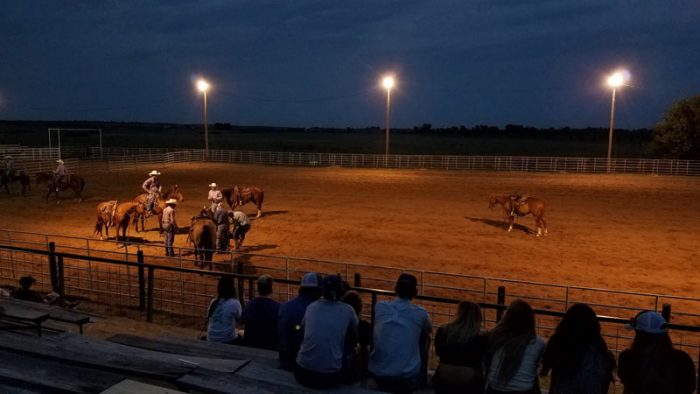
But it isn’t simple. It isn’t innocent. The pains of living don’t respect distance. They travel even along these long empty highways and into the small towns. We lose people to suicides. We lose people to drunk driving. To drugs.
The pre-Fair edition of the local paper this year ran dozens of advertisements from all the local businesses praising the 4-H kids and cheering on the contestants in the animal events. The paper was at least two pages longer than normal, just to accommodate all the County Fair-related ads. In the midst of all that promotion, though, was an article reminding readers that Meth is still ravaging the rural center of the country. With all the focus on opioids and fentanyl, the article said, some are forgetting that we’re still losing too many people to meth. It isn’t disappearing.
Watching the rodeo riders wave their lassos, I remembered stories I heard as a child about the drug culture among the ranch workers and rodeo cowboys. I’ve only heard more stories over the years. I’ve seen more men with sunken cheeks. Seen skinny, jittery couples at the grocery story with the telltale mottled skin, the flat set mouths.
I knew friends in South Dakota who had tried Meth. When I would ask them about it, they tended to say, “It’s around, you know?” They would shrug it off. I know enough by now, after ten years in Kansas, to see that it’s still around. So are the opioids. It isn’t getting better yet. Maybe someday, but not yet.
People are less wealthy here, and that’s a hard life wherever you are. But it’s easier to be poor on the Plains. Housing is cheaper, gas is cheaper, groceries are often cheaper than they are in bigger places. There are always jobs, even if they aren’t glamorous or high-paying. No one looks down on you for taking them. People respect hard work around here, more than any other trait.
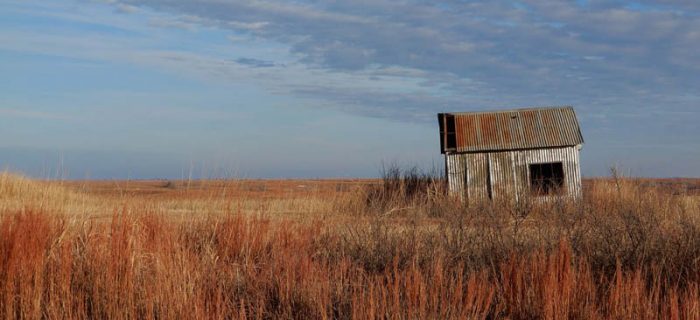
I often think about picking up some shifts as a waitress in a local diner to bring in a little extra money. The only thing that has stopped me so far is shyness, and that I can’t seem to find enough time. I know I’d only make more friends, and be better-known in town, probably better-liked, if I did. Maybe one of these days I’ll get it together. I do know I’d rather work in a Kansas diner than just about any other job. I would feel that I was doing something useful, something needed. I like hard work as well as anyone. I don’t mind being on my feet for hours.
In this culture of hard work, a premium is placed on physical strength and physical know-how. It’s only practical when you live in a place where you could easily be stranded on the side of the road for hours. Where cell service fades when you stray off the main roads and experts are often an hour away. It’s a good idea to know how to do things yourself out here. So people work hard, and they value hard work in each other. But then it’s usually the hard work that wears them out.
Hard work, whether it’s on a ranch or in the oil fields, or in one of the construction trades, breaks down the body. By the time the men, in particular, reach old age, they are often in pain all the time. They spend ever more hours in their doctors’ offices and in the pharmacy. I think about how it must trouble these men, after a life of complete self-reliance, to apply for that first disability check. The psychological toll that must take. But there are a lot of people living on disability in this town.
When I’m in the grocery store, I stop to chat with people I know. After a decade, I know a few people. But stopping to chat, each time, I seem to learn the new names of pills to take for the heart, pills to take for the lungs, for the liver, and all the different pills for pain. There are so many different pills flowing through this town. There’s a common refrain of weariness—another doctor’s visit this week, another blood test. I begin to feel that weariness myself, and a vicarious fear of the doctor’s office. I think about time passing, and how many of these warm, wonderful people I will lose to disease and disability. The universe isn’t making as many of these people now. It feels like there are fewer of them each year. Sometimes I worry for the future of this little town.
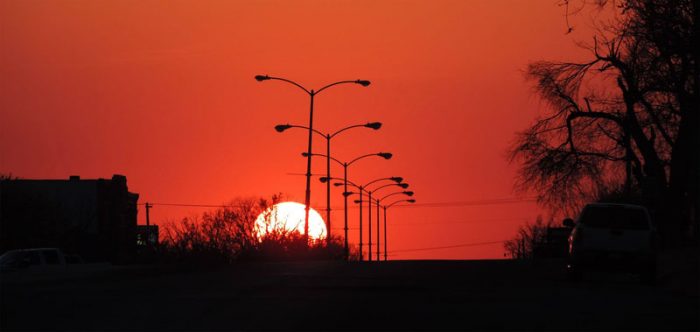
*** *** ***
The plains aren’t just one thing. I tend to use the words—“high plains” and “great plains” and “prairie”—interchangeably. But if I wanted to be more specific, I would pin this place at the far eastern edge of the high plains, near the hundredth meridian, where the rainfall totals fall off precipitously in the leeward shadow of the Rocky Mountains. Viewed from the atmosphere, we’re situated in the southern center of the Great Plains, a vast area of subtle hills and valleys which would also include my childhood home in South Dakota. I live now in the mixed grass prairie. This is the liminal region between the rich tallgrass prairie croplands to the east and the dusty shortgrass prairie rangelands to the west. Neither eastern nor western. Neither northern nor southern. Once, this area was known as the cattle kingdom. Before the fences, it was home to the herds and the cowboys who kept them. Before that, it was home to buffalo and the Kiowa and Comanches. It’s seen Spanish explorers and British cattle barons, but this is a place that has never felt fully “settled” by humans. Even now, or maybe especially now, human settlement here feels precarious, as the populations of these small towns dwindle and concentrate themselves into the few lively hubs of economic activity—Dodge City, Hays, Wichita.
When I think of this town, I think of the people. But when I think of the Plains, I think of the land. Nothing makes me feel small, nothing makes me feel expendable, quite like the view out over the prairie. The grasses that stretch on for miles. In that Rothko-view of the world, there is land. There is sky. One person doesn’t even register against the black line of the horizon. The first easterners to meet this view called it a Great Desert. They were frightened by its vastness, its treelessness, and the rare supply of water. They preferred to follow the rivers, and beat a hasty path to the western forests.
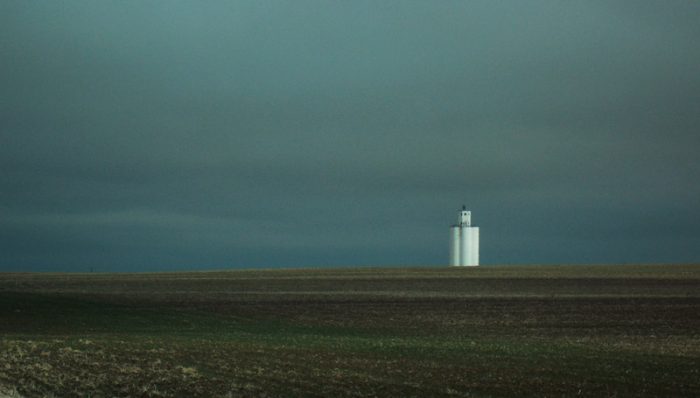
The land is bigger than anything. It dwarfs the tiny towns, our little islands of population among a Pacific Ocean of prairie. The work of these towns is oriented to the fields, and to cultivating the vastness. We are outnumbered by our grasses, by the ears of corn grown in the millions, by the grains of sorghum in the billions. We are out-worked by our soil, which raises the crops, and feeds and sustains the large cattle herds. The food grown here travels around the world.
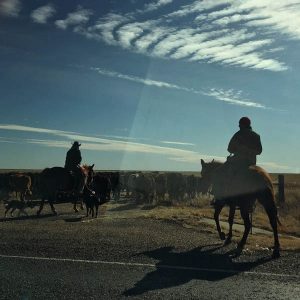
The land is engaged in a business that is larger and more modern, and less human, that we can understand by looking at it. The land is a big business. It wakes and sleeps on the clock of Agri-Business, operating at a fearful scale. Its mechanisms, the levers and pulleys of agricultural markets, are operated out of Kansas City, Chicago, Brazil… Its fortunes rise and fall with the stomping feet of trading floors. I listen to the farm radio station, and I read articles about futures and markets, but I don’t know how it all operates. I’m not sure anyone knows how it all operates.
It isn’t the form of agriculture that I would choose, if I were the one choosing. It overwhelms the land. It overwhelms the people who work the land. I don’t think many of the farmers and ranchers would choose this globalized, consolidated agricultural market either, if they could afford to choose. They have little control. The pressure is to work too much land too intensely, and at too thin a margin. They sell their meat at continually lower prices, kowtowing and improvising to the whims of the big four corporate buyers. The debt required to purchase land and equipment continues to rise. The strain is impossible on the younger generation, who can’t raise enough to cash to fight their way into the industry. The pain deepens for the older generation, who live in constant fear of ruin. The big operators are so big. The small operators are dwindling. I’ve never worked in agriculture, and I don’t like to criticize things I don’t fully understand. But, from what little I know, I wouldn’t choose this global-industry model of farming or ranching. And I don’t think any of the men and women who know more than I do would choose this model, if they could choose otherwise. If only any of us could choose otherwise.
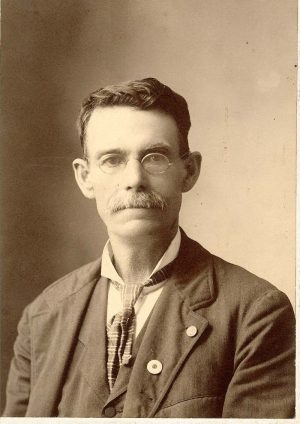
We don’t have a Sockless Jerry Simpson now. We could use him, the populist rancher and sometime sewer-digger from Medicine Lodge. Back in 1890, Jerry reached the halls of the U.S. Congress on a platform of pure prairie fire—against the railroad interests and the bankers. With his “hot heart and electric mind”, he could rally men out of the farms and into the ballot boxes. He stood with his constituents when they had begun to burn their own corn fields in protest. We don’t have his cause, the foundation of which, he said, “was laid as far back as the foundation of the world.” Sockless Jerry’s struggle between “the robbers and the robbed” was fought hard in this state until it was finally cowed by the banks, by the railroads, by the modern economy and its efficiencies. Now very few remember the fervor and the heat of the populist farmers and ranchers. That war was lost a long time ago.
In that way, we are as modern out here as anywhere in the world. The plains are piece and parcel of the global economy, which is so big that it overwhelms us before we are old enough to understand. We are raised to accept how little control we have. This is nothing new. Wildfires always tore through the fields. Tornadoes dropped out of the clouds and wiped whole settlements off the map. Years and decades of droughts. Swarms of insects descending on the crops. That’s all to be expected. Misfortune. Disease, death, loss. These are all in the natural order of things. The rain falls in June, and then stops. The grasshoppers arrive with the heat.
On top of the natural order is the newer order. The economic order, where money drops like a storm out of the sky, and enriches one field this year, destroys that same field the next year. Money can bring a manufacturing plant to one town. It can bring an industrial-scale feedlot to the next. When Money recedes, the streets wither into dust. Fortunes come and go.
The Money itself is somehow never here. Money doesn’t belong to this place. It passes through, granting wishes and offering promises to the lucky few. When it withdraws, the people stumble after it. They ask it, please, to come back. “What will you give me in return?” the Money asks…Too often, the answer is Anything. Anything.
You can’t blame the people who live on the prairie for the realities of this world. We only work here. We don’t make the rules. We’re little and the Money is big. It speaks with an incontrovertible voice, like the voice of history, and decides what rises and what falls.
And even as I sigh over everything that is wrong with this world, I find it beautiful. To stop and watch a combine, the modern factory at work, as it churns through the fields at dusk. The way the cloud of wheat dust rises over the cab and catches the light. To see the men stringing fence, and the herds in the summer grasses. When I stand between the towering rows of corn stalks, I still feel impressed. I feel proud. This is what we do here—grow crops, feed the world. When Sockless Jerry Simpson was asked why he moved to Kansas, he replied, simply, “The magic of a kernel. The witchcraft in a seed; the desire to put something into the ground and see it grow and reproduce its kind.” That germ of romance—the witchcraft of the seed—is still alive in the fields. It isn’t simple, or innocent, but it’s there. It’s beautiful.
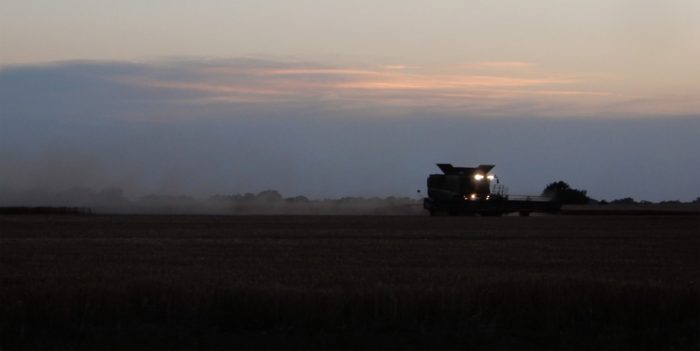
*** *** ***
It’s common to be born and raised, and to reach adulthood on the plains with very little knowledge of the history of this land. I managed it myself. I still don’t know very much. Maybe a little more than the average person, who knows absolutely nothing about it.
It’s likely that someone tried to teach us in school. I have vague memories of teachers talking about sod houses and the Plains Indian Wars. It struck me as a very brown and dusty kind of history—cattle trails, massacres, wagon trains. I didn’t pay attention. Barbed wire was the stuff that ripped your leg open when you crossed through a field with your friends. The idea that the twisting fenceline, unspooled across the grasses, had been foundational to the history of this country was beyond me. Windmills, which brought agriculture from the creek beds out into the dry country, appeared purely decorative to a late-20th century kid. Now I’m pleased and surprised when I find one that’s still standing. On a few occasions, I’ve discovered a windmill turning sedately next to a stock tank, and a new shiny solar panel mounted beside it. This always seems a little sad. But time passing doesn’t particularly care about sadness or nostalgia. The windmills were here before me, and I hope a few survive after I’m gone.
Horses, though, are eternal. The horses arrived on the plains with the Spanish. They’ll remain forever. You don’t need to read a page of history in order to love horses.
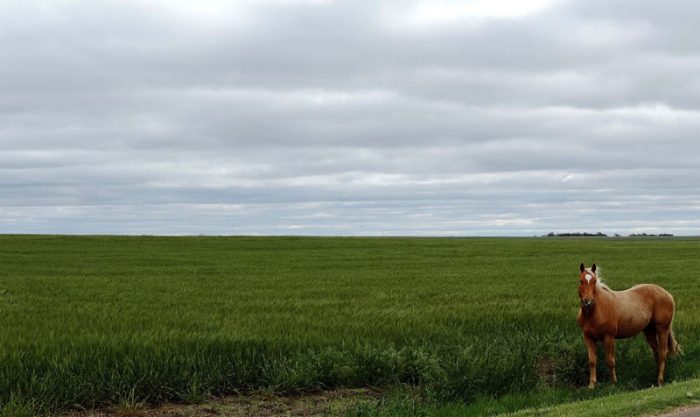
*** *** ***
We arrived at the County Fair Horse Show this summer in time to see the presentations of the youngest group. One after another, little cowboys and cowgirls led their animals across the dirt to meet the judge. One sober-faced three-foot high buckaroo came out. He stood shyly beneath the neck of his horse while the judge looked back at its haunches.
Behind me in the stands, I could hear a few middle-school aged girls talking as they watched the proceedings. They were straddling two worlds. One, the hot and dusty evening at the rodeo arena. The real and present world. The other world they described was digital and, to my mind, completely unreal.
“So, one of my videos has over 9000 views now,” one was saying. “Oh wow,” another chimed in. “I’ve only hit 4000 once.” This second girl paused. “That was sort of, like, my fan account, though. I’m thinking I might get rid of that one. I’d only keep it because a couple of the people followed back…”
They all stopped for a moment as the scattered crowd in the stands let out an “OH!” A little boy’s cowboy hat had blown off and landed behind him. He was trying to keep hold of his horse while chasing after it.
“My sister’s friend,” one of the girls behind me broke in, “had an account with, like, thousands and thousands of views, and she deleted practically the whole thing. She only has three or four videos on there now.”
“Oh wow,” said another. “That’s crazy.”
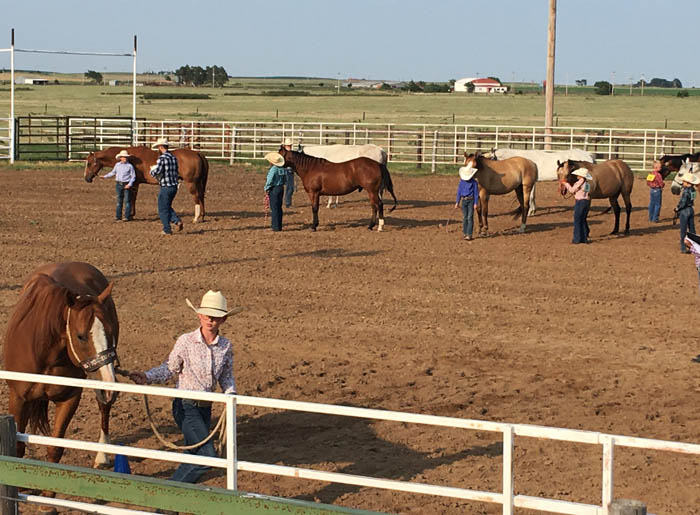
It was impossible not to listen to this bizarre conversation, even as I smiled to see a slight little bespectacled blonde cowgirl leading her pony to the judge. The line of the contestants was in constant reshuffling motion behind her. One boy’s horse kept wandering too close to another, and then each horse would decide to move farther away. Little cowboy hats were flying off at regular intervals.
In front of us in the stands was a mixed group of high school kids. They kept laughing and jostling each other, drinking their sodas. One boy was steadily wolfing his way through a paper plate of nachos. One girl with long straight hair and comically fake eyelashes suddenly squealed, “Oh, it’s my brother!” She poked the boy next to her and the group quieted and looked out at the rodeo grounds. “Yeah!” She cheered. The little boy in the arena smiled and led his horse to stand with the others. “Yeah!” One of the girl’s friends cheered. The little boy waved from his place in line.
Another tiny little girl led her horse out into the ring.
“Oh, I know her,” said one of the middle school girls behind me. “That girl’s been riding, like, since before she could walk. She does all this rodeo stuff.”
A pause and one of the other girls said, “I really wanted to get into barrel racing this year. None of my horses are fast enough.”
“Oh yeah,” another girl agreed. “You need the right horse.”
Another pause. “Anyway,” the first girl said, “I saw this video the other day with, like, ten thousand views…”
I stopped listening. At that moment, the world’s tiniest cowboy was entering the arena, dragging a half-ton horse behind him. The horse seemed completely uninterested in walking across the dirt, or meeting the judge. It gave every appearance of wanting a nap. But the little boy was determined. He pulled and yanked and he nearly fell over in the dust. And he pulled again and slowly, slowly, the horse was coaxed across the ring.
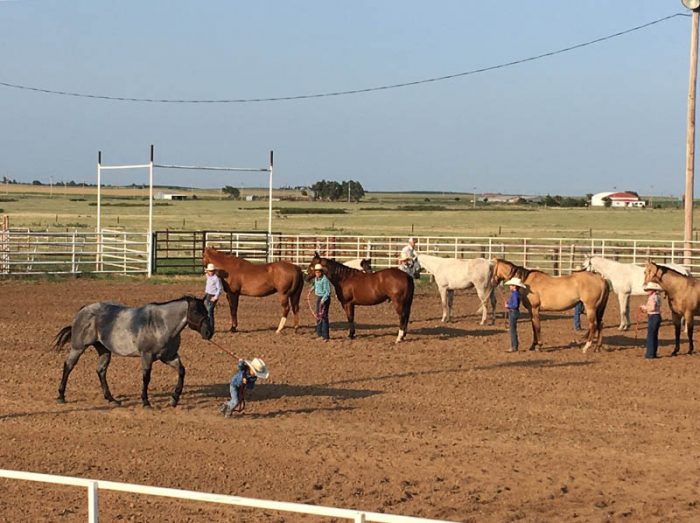
Everyone in the bleachers was chuckling and a few were clapping. The judge covered her mouth, to keep from breaking the seriousness of her role.
“You’ve got this!” An older cowboy yelled from the stands.
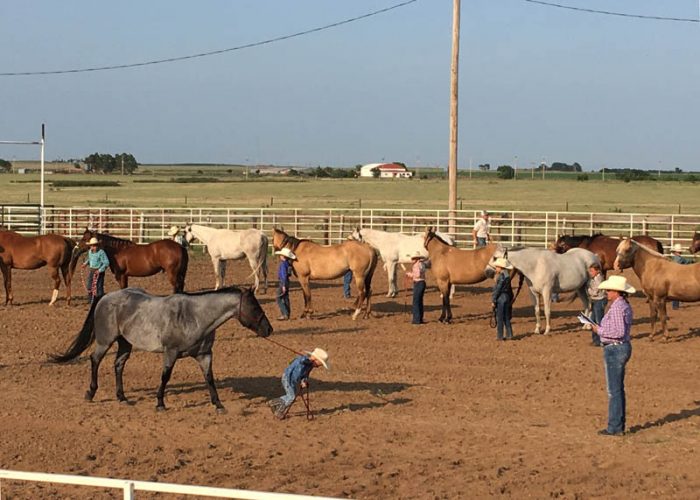
Finally the little boy stopped, exhausted, in front of the judge. He let his arm drop with the slackened rope. He stared up at the woman, and put his other hand on his hat, holding it down to his head. The judge smiled down at him from over her clipboard. She looked over the horse, and told the boy where to stand with the others in line. He nodded slowly and pulled at his horse until it grudgingly agreed to walk over and stand with the others.
When the judging was over, and the horses were beginning to file out of the arena, the judge stopped the last tiny little boy. “You did a great job,” she told him. Her voice carried across the dirt. I saw nodding heads around me in the stands. “You worked harder than anybody,” she said. “Good job.”
The little boy smiled shyly down at his cowboy boots and said “Thank you.” He led his horse out of the ring.
I didn’t quite know what to make of this scene. The girls behind me were still talking about videos—I don’t know what app they use now. It doesn’t matter. Given a couple more years, the digital world will grab them with something else. The high school kids were still wrapped up in each other, laughing at each other’s jokes. One boy put his arm around one of the girls, and she smiled. This was familiar. The world of a teenager in a prairie town. A rodeo is as good as a football game is as good as an empty parking lot. It’s just a place to hang out with your friends.
The other adults in the stands were looking tired and hot after a day of fair events. Most appeared to be involved in the proceedings, either showing their own animals or else tending to their kids’ 4-H activities. Most were wearing boots and hats, marking themselves as members of the agricultural world. When the night was over, they would get in their trucks and drive home to the ranch. They’d be back for the events the next evening.
I wondered about the tiny little cowboy with the big horse. I was sure his family had heard what the judge said to him. He had worked harder than anybody. There’s no higher compliment. I was sure they were proud to hear that. I thought of his little cowboy hat, his little cowboy boots. It must make his father happy to see him.
Maybe there’s just something about a County Fair. Somehow I end up believing again in the possibility of simplicity. Even innocence. I’ve lived here for more than ten years, and all I’ve learned is that there aren’t any clear answers. But it’s my home. I love it here. I still raise a little flag of vulnerable hope that it will survive.
Tonya Audyn Morton is the former publisher & managing editor of The Zephyr. She is now the founding publisher/editor and frequent contributor to “Juke,” an arts and literature journal on Substack. Zephyr readers can access Tonya’s page here. And on Facebook.
To comment, scroll to the bottom of the page.
Zephyr Policy: REAL NAMES ONLY on Comments!
Don’t forget the Zephyr ads! All links are hot!
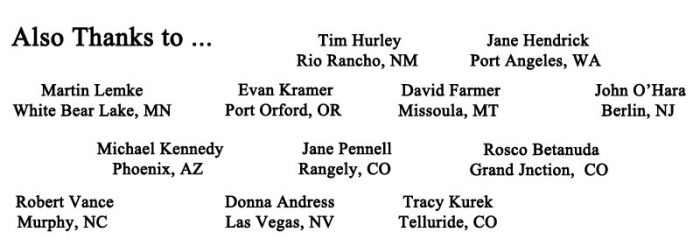



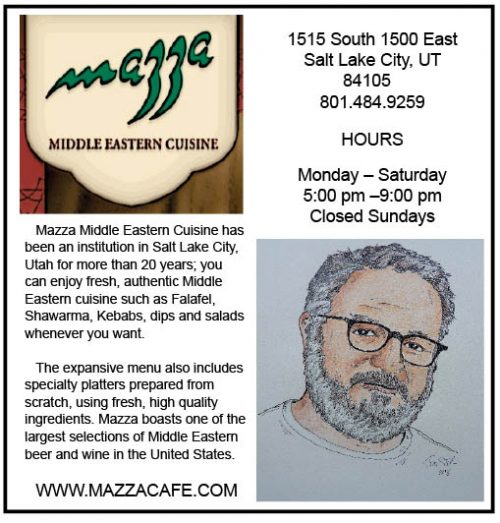

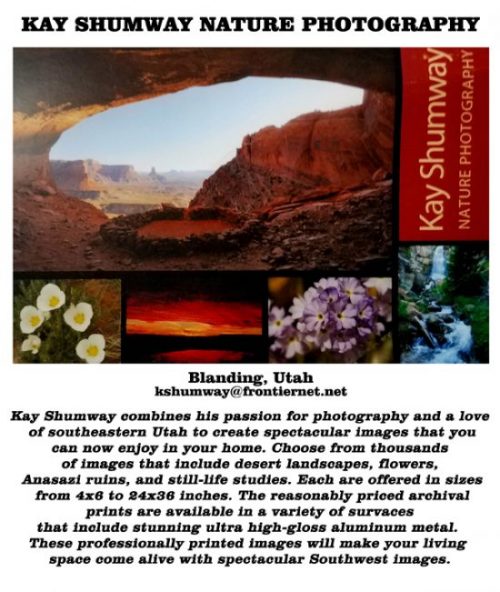
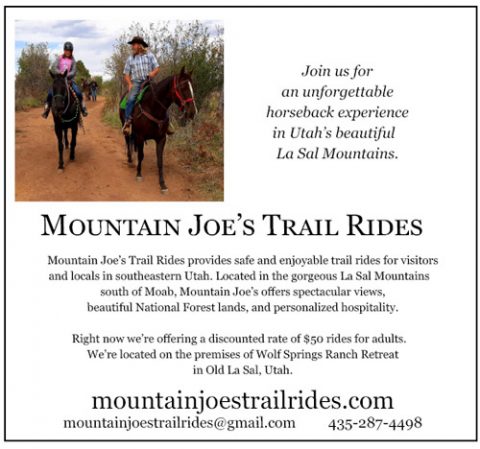
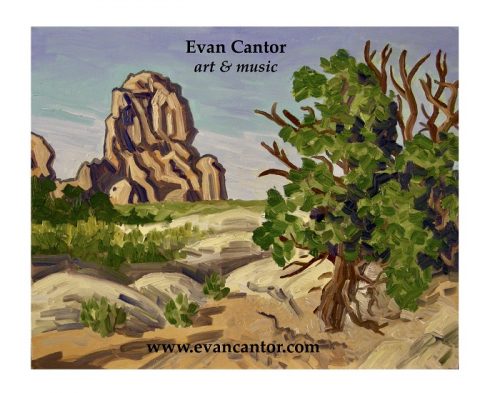
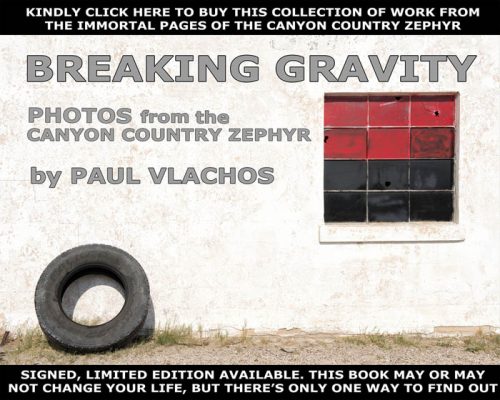
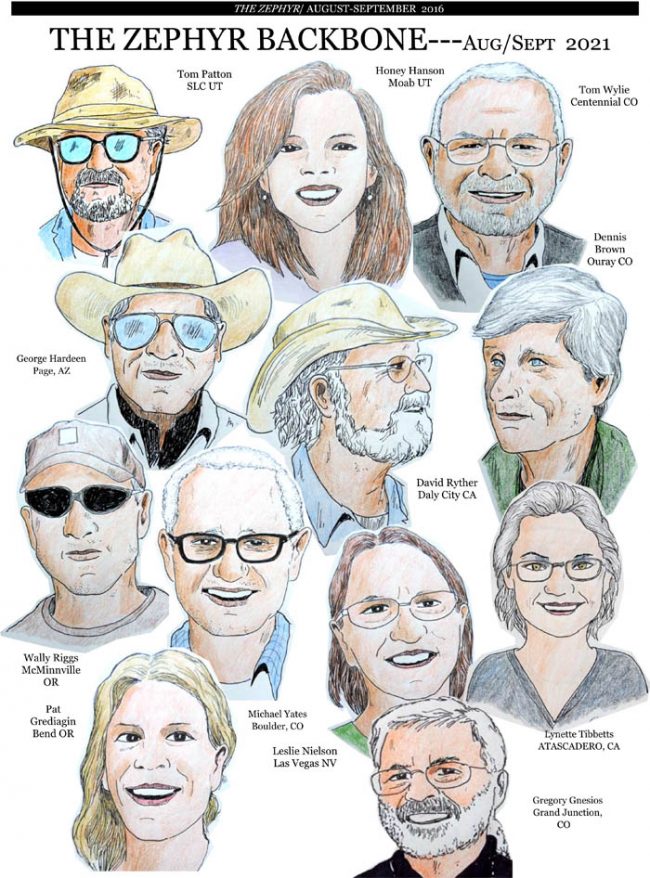
Thanks, Tonya. I’m still a fan of the Zephyr 15 years after leaving Moab for Grand Junction then on back home to Texas. My wife and I made another trip across the Great Plains this summer to visit kids and grandchild in South Dakota. Life is “slower” on the plains and we relaxed as we made our way north and then back south on a parallel route, avoiding interstate highways, staying on “back roads” as US Highways are now called. We explored Oklahoma, Kansas, Missouri, Iowa, Nebraska and South Dakota. I wondered aloud, several times, when we rolled in to little hamlets in Kansas “…reckon this is where the Stiles’ are?”.
I have long hoped that people love where they live…because I know I do and I didn’t want everybody moving to Colorado. Well, that horse is outta the barn now.
Tonya: Jim probably nose heez stepping a-sighed 4 U 2 take over this enterprise — sooner, & prawbubbly knot layter. U have a weigh of entrancing the reader into your entrapsingly whirl-pooling enrapturing (and dare i say “snaringly?”) development of the story? i wuzz hooked from the begging-ing. Jim will, if not awlreddee, give you the reins to guide this pony-express ride as he werx in the back-room to furthur promulgate the CCZ enterprize. N-joid yore story M-n-ssly! (chex N the mayell) ~
and get jim to spell ‘betunada” correctly (not that i really care)